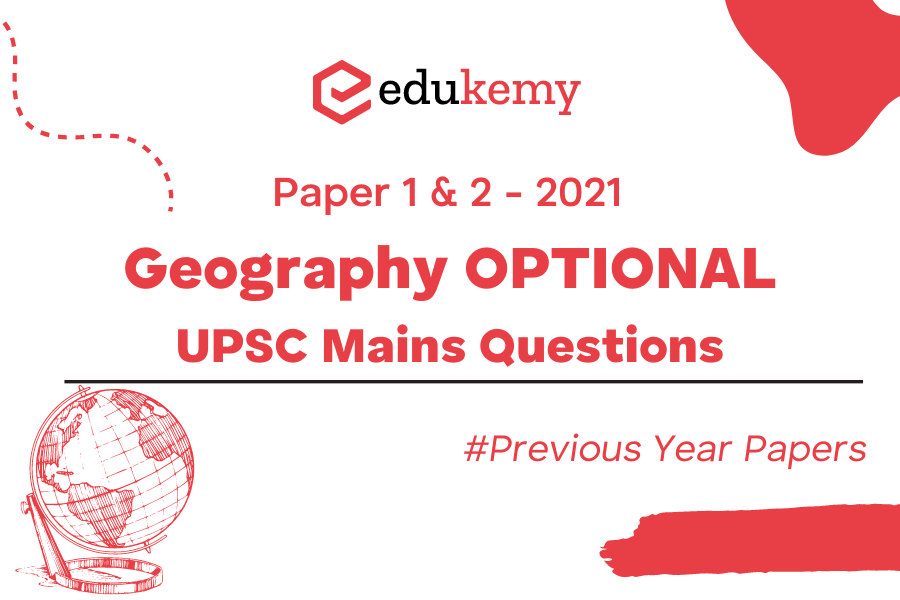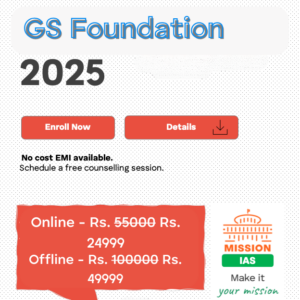The UPSC (Union Public Service Commission) Mains examination is a crucial stage in the journey of candidates aspiring for prestigious civil services in India. Among the various optional subjects available, Geography holds significant importance, attracting candidates with a keen interest in understanding the Earth’s physical and human aspects. The UPSC Mains Geography Optional Previous Year Paper for 2021 serves as a valuable resource for aspirants preparing for the upcoming examinations. This paper not only reflects the evolving nature of the examination but also provides insights into the examination pattern, question types, and the depth of knowledge expected from candidates. Analyzing the Geography Optional Previous Year Paper for UPSC Mains 2021 is essential for a comprehensive preparation strategy, enabling candidates to align their studies with the examination’s demands and enhance their chances of success in this highly competitive arena.
Question Paper Specific Instructions
- Please read each of the following instructions carefully before attempting questions :
- There are EIGHT questions divided into two SECTIONS and printed both in HINDI and in ENGLISH.
- The candidate has to attempt FIVE questions in all.
- Questions no. 1 and 5 are compulsory and out of the remaining, THREE are to be attempted choosing at least ONE from each section.
- The number of marks carried by a question/part is indicated against it.
- Answers must be written in the medium authorized in the Admission Certificate which must be stated clearly on the cover of this Question-cum-Answer (QCA) Booklet in the space provided. No marks will be given for answers written in a medium other than the authorized one.
- Word limit in questions, wherever specified, should be adhered to.
- Illustrate your answers with suitable sketches, maps, and diagrams. These shall be drawn in the space provided for answering the question itself.
- Attempts of questions shall be counted in chronological order. Unless struck off, the attempt of a question shall be counted even if attempted partly. Any page or portion of the page left blank in the answer book must be struck off.
Geography Optional Question Paper-1 (2021)
SECTION A
Q. 1
(a) Describe the concept of Altiplanation.
(b) What are the important factors responsible for Airmass modifications?
(c) Discuss the hazards associated with the rising of sea surface temperature.
(d) Gene pool centres are Good Hope for biodiversity conservation. Elucidate.
Q. 2
(b) Give a detailed account of the bottom topography of the Pacific Ocean.
(c) Soil erosion and Soil degradation are threats to the food supply. Discuss.
Q. 3
(a) Examine major influencing factors for varied patterns of precipitations on the continents.
Q. 4
(c) Indicating the causes of lightning, describe the threats associated with it.
SECTION B
Q. 5
(b) How is energy transition seen as an instrument for achieving zero carbon by 2050?
(c) Protected cultivation assists in healthier and larger produce. Justify with examples.
(d) Explain the processes of contagion and hierarchical diffusion in addressing regional imbalances.
(e) Examine the relevance of the Central Place Theory of Christaller in the present context.
Q. 6
(a) Development-induced displacement poses serious challenges. Mention its causes, consequences, and solutions.
(b) Describe the role of accessibility and affordability in the food security of the developing world.
(c) The environmental issues are not adequately addressed in the regional planning. Comment.
Q. 7
(a) Suggest criteria, indicators, and techniques for delimitation of formal regions.
(b) Boundaries are important in geopolitics. Explain. What issues develop from the inclusionary and exclusionary aspects of borders.
(c) Small number of mega-cities are playing a key role in organization of global economics and culture. Explain.
Q. 8
(a) Why is radicalism seen as major a paradigm shift in geography? Explain its causes, approaches, and criticism.
(b) Aging population has adverse social and economic consequences. Explain with examples.
(c) Present a critical account of Alfred Weber Theory of Industrial location.
Geography Optional Question Paper-2 (2021)
SECTION A
Q. 1
- Ziro Valley
- Khecheopalri Lake
- Toranmal
- Subarnarekha River
- Koderma
- Sir Creek
- Periyar Wildlife Sanctuary
- Peechi Dam
- Digha Beach
- Pamban Island
(b) Discuss the geopolitical impact of the bilateral relationship between India and Bhutan.
(c) Discuss the economic significance of the volcanic soils of India.
Q. 2
(b) Appraise why drought is one of the most common climatic extremes in India.
(c) Discuss the ecological and economic challenges of river linking in India.
Q. 3
(a) Discuss the importance of solar energy in the future economic development of India.
Q. 4
(a) Discuss the reserves, distribution, and production of all varieties of coal in India.
(b) Describe the salient features of the east-flowing rivers of India.
(c) Critically examine the problems of inter-State border disputes in India.
SECTION B
Q. 5
(a) Discuss the salient features of Project Tiger in India.
(b) Describe the problems of cloud burst in India giving suitable examples.
(c) Discuss the role of watershed management for soil and water conservation in hilly regions of India.
(d) Critically examine the relevance of Ravenstein’s law of population migration with reference to India.
(e) Discuss Ashok Mitra’s classification method of Indian cities.
Q. 6
(a) Explain the impact of tropical cyclones and western disturbances on the climate of India.
(b) Examine the critical issues of groundwater resources in India.
(d) Describe the structure and relief features of the Deccan Plateau.
Q. 7
(a) Critically examine how the Panchayati Raj system is a catalyst in decentralized planning in India.
(b) Identify the major industrial corridors of India and discuss the characteristics of the Bengaluru-Mumbai Corridor.
(c) Assess the growth of multinational corporations in the liberalized economic environment of India.
Q. 8
(a) Examine how information and communication technology has boosted the development of certain regions of India.
(b) Discuss the Command Area Development Programme and its impact on eliminating regional inequalities in India.
(c) Critically assess the status of the balance of trade in India and suggest some measures to combat the issues.
Frequently Asked Questions (FAQs)
1. Question: What is the significance of geomorphic cycles in understanding landscape evolution?
Answer: Geomorphic cycles are essential in understanding landscape evolution as they represent repetitive patterns of landform development over geological time. These cycles provide insights into the dynamic processes shaping the Earth’s surface, helping geographers decipher the long-term effects of factors such as tectonics, climate, and erosion on landscapes.
2. Question: Discuss the role of remote sensing in modern geographical research.
Answer: Remote sensing plays a crucial role in modern geographical research by providing valuable spatial information about the Earth’s surface from a distance. It aids in monitoring environmental changes, land use, and natural disasters. Technologies like satellite imagery and GIS enable geographers to analyze, interpret, and model spatial data, facilitating a better understanding of geographical patterns and trends.
3. Question: Explain the concept of regional planning and its significance in sustainable development.
Answer: Regional planning involves the systematic organization of land and resources within a specific area to achieve balanced development and sustainability. It aims to address social, economic, and environmental issues at a regional scale. Effective regional planning promotes equitable growth, minimizes environmental degradation, and enhances the overall quality of life for communities.
4. Question: How do plate tectonics influence climate patterns on a global scale?
Answer: Plate tectonics influence climate patterns through the interaction of tectonic plates, which affect the distribution of continents and oceans. Changes in landmass positions influence ocean currents, atmospheric circulation, and precipitation patterns. For example, the Himalayas influence the monsoon system in South Asia. Understanding these interactions is crucial for predicting and adapting to long-term climate changes.
5. Question: Discuss the role of cultural ecology in understanding human-environment interactions.
Answer: Cultural ecology explores the relationship between human societies and their environments. It emphasizes how cultural practices and beliefs influence the way people interact with and adapt to their surroundings. By studying cultural ecology, geographers gain insights into how human activities impact ecosystems and vice versa, informing sustainable practices and resource management strategies.
For UPSC Prelims Resources, Click here
For Daily Updates and Study Material:
Join our Telegram Channel – Edukemy for IAS
- 1. Learn through Videos – here
- 2. Be Exam Ready by Practicing Daily MCQs – here
- 3. Daily Newsletter – Get all your Current Affairs Covered – here
- 4. Mains Answer Writing Practice – here
Visit our YouTube Channel – here


